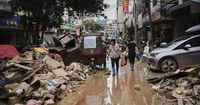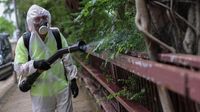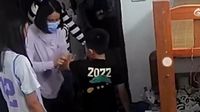Southern China is grappling with its largest-ever outbreak of the mosquito-borne chikungunya virus, a crisis that has prompted sweeping public health measures and revived memories of pandemic-era controls. The epicenter is Foshan, a bustling manufacturing city in Guangdong province, about 170 kilometers from Hong Kong. As of August 9, 2025, officials report over 7,000 confirmed cases, with the outbreak spreading rapidly to at least 12 cities in the region, according to Bloomberg and BBC News.
Chikungunya, pronounced chik-un-GUN-yuh, is no stranger to global health experts. First identified in Tanzania in 1952, the virus has circulated in over 110 countries, primarily in Africa, South and Southeast Asia, and now, with alarming prominence, southern China. The World Health Organization notes that symptoms typically appear three to seven days after a mosquito bite: sudden high fever, intense joint and muscle pain, rashes, headaches, and joint swelling. While most recover within a week or two, some endure chronic joint pain for months or even years. Deaths are rare, but newborns, the elderly, and those with chronic illnesses face greater risks.
What makes this outbreak particularly noteworthy is that chikungunya had never established itself in mainland China before. As César López-Camacho of the University of Oxford told BBC News, "This suggests that most of the population had no preexisting immunity, making it easier for the virus to spread quickly." The rapid transmission has left both residents and authorities scrambling to respond.
Foshan’s local government has rolled out a suite of aggressive interventions. Streets, residential neighborhoods, and construction sites are being doused with insecticide, while drones hover overhead, scanning for pools of standing water—prime breeding grounds for the virus-carrying mosquitoes. In hospitals, patients are kept under mosquito nets, and purchases of fever and pain relief medications are being closely monitored, echoing tactics used during China’s Zero-COVID strategy, as reported by Bloomberg.
Communities have mobilized for mass disinfection campaigns and seven-day health drives, especially in high-risk towns like Lecong. Residents are strongly encouraged to install window screens and sleep under mosquito nets. In a coordinated effort, entire neighborhoods light mosquito coils at the same time each evening, hoping to maximize the repellent effect. Authorities have distributed mosquito nets and issued stern warnings to empty outdoor containers that might collect water. Fines for non-compliance can reach up to 10,000 yuan (about $1,400), and in extreme cases, electricity disconnection is threatened for persistent offenders.
Businesses are not exempt from scrutiny. They face fines of up to 1,000 yuan if they fail to eliminate mosquito habitats on their premises. The city has also trialed biological controls, such as introducing fish that feed on mosquito larvae and larger mosquito species that prey on the virus carriers.
Dr. Donal Bisanzio, a senior epidemiologist at RTI International, told BBC News that, "Rather than lockdowns or digital tracking, outbreak control should focus on vector management and reducing human mosquito contact." The approach reflects a shift from the person-to-person transmission fears of COVID-19 to the unique challenges of vector-borne diseases.
Initially, Foshan authorities mandated that patients remain hospitalized for at least a week. There was even a brief period of enforced two-week home quarantines, but this was quickly abandoned once it became clear that chikungunya cannot be spread from person to person—only through mosquito bites.
The outbreak’s timing couldn’t be worse. Unseasonal heavy rains and record-high temperatures have created ideal conditions for mosquito proliferation. As Kang Min, Director of Guangdong CDC’s Institute of Infectious Disease Prevention and Control, explained to local media, while the number of new cases is finally slowing, "challenges remain due to international travel and the flood season, which fuels mosquito breeding."
International concern has grown as the outbreak’s reach extends. The US State Department has issued a travel advisory urging visitors to Guangdong province to take extra precautions. The first imported case in Hong Kong—a 12-year-old boy who had recently visited Foshan—has heightened global attention. According to eNCA, Professor Tulio de Oliveira from South Africa’s Centre for Epidemic Response and Innovation noted that the variant responsible for the current crisis originated in Réunion Island in March and has mutations that allow it to spread more efficiently through certain mosquito species.
"Climate change and rising temperatures are expanding the areas where mosquitoes thrive, which could lead to more chikungunya cases," Professor de Oliveira warned. He emphasized that while South Africa faces little risk during its winter months, vigilance is needed as summer approaches and mosquito populations rise.
China’s response is reminiscent of its past epidemic control strategies, particularly those deployed during the SARS outbreak and the COVID-19 pandemic. National-level meetings and emergency protocols underscore the government’s determination to stamp out the outbreak and avoid international criticism. The scale of the effort is considerable—mass testing, community mobilization, and strict enforcement of public health regulations are all in full swing.
But what does all this mean for the average resident or traveler? The advice from health authorities is clear and practical: use mosquito repellent daily, especially during humid and rainy seasons; install screens on windows and doors; sleep under mosquito nets if you live near standing water; wear long sleeves and pants when outside at dawn or dusk; and eliminate stagnant water in plant pots, buckets, or any outdoor containers. If you’ve traveled to an affected area and develop symptoms such as fever, joint pain, or rash, see a doctor promptly and mention your travel history. Early detection helps avoid complications and prevents further spread.
Chikungunya’s symptoms, while often manageable, can be severe. The name itself comes from the Makonde language, meaning "that which bends up," a nod to the contorted posture sufferers sometimes adopt due to excruciating joint pain. Most people recover without specific medical treatment, but in rare cases, persistent pain can last for months or even years, and hospitalization may be needed for complications like organ damage. Vaccines do exist, but they’re mainly approved for travelers and remain inaccessible to most people in high-risk regions.
Looking ahead, experts warn that the combination of climate change, increased international travel, and urbanization could make outbreaks like this more common. The current crisis in southern China is a stark reminder of the global threat posed by mosquito-borne diseases and the importance of robust, flexible public health responses.
For now, residents of Foshan and neighboring cities are adapting to a new normal—one filled with the hum of drones, the scent of insecticide, and a collective determination to outsmart a tiny but formidable foe.






